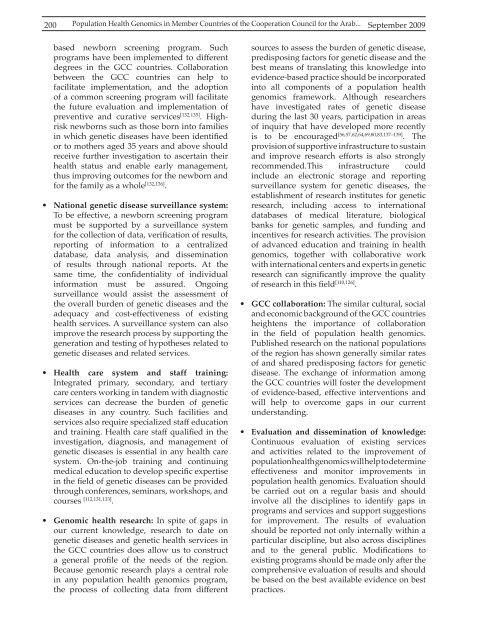Vol 41 # 3 September 2009 - Kma.org.kw
Vol 41 # 3 September 2009 - Kma.org.kw
Vol 41 # 3 September 2009 - Kma.org.kw
You also want an ePaper? Increase the reach of your titles
YUMPU automatically turns print PDFs into web optimized ePapers that Google loves.
200<br />
Population Health Genomics in Member Countries of the Cooperation Council for the Arab...<br />
<strong>September</strong> <strong>2009</strong><br />
based newborn screening program. Such<br />
programs have been implemented to different<br />
degrees in the GCC countries. Collaboration<br />
between the GCC countries can help to<br />
facilitate implementation, and the adoption<br />
of a common screening program will facilitate<br />
the future evaluation and implementation of<br />
preventive and curative services [132,135] . Highrisk<br />
newborns such as those born into families<br />
in which genetic diseases have been identified<br />
or to mothers aged 35 years and above should<br />
receive further investigation to ascertain their<br />
health status and enable early management,<br />
thus improving outcomes for the newborn and<br />
for the family as a whole [132,136] .<br />
• National genetic disease surveillance system:<br />
To be effective, a newborn screening program<br />
must be supported by a surveillance system<br />
for the collection of data, verification of results,<br />
reporting of information to a centralized<br />
database, data analysis, and dissemination<br />
of results through national reports. At the<br />
same time, the confidentiality of individual<br />
information must be assured. Ongoing<br />
surveillance would assist the assessment of<br />
the overall burden of genetic diseases and the<br />
adequacy and cost-effectiveness of existing<br />
health services. A surveillance system can also<br />
improve the research process by supporting the<br />
generation and testing of hypotheses related to<br />
genetic diseases and related services.<br />
• Health care system and staff training:<br />
Integrated primary, secondary, and tertiary<br />
care centers working in tandem with diagnostic<br />
services can decrease the burden of genetic<br />
diseases in any country. Such facilities and<br />
services also require specialized staff education<br />
and training. Health care staff qualified in the<br />
investigation, diagnosis, and management of<br />
genetic diseases is essential in any health care<br />
system. On-the-job training and continuing<br />
medical education to develop specific expertise<br />
in the field of genetic diseases can be provided<br />
through conferences, seminars, workshops, and<br />
courses [112,131,133] .<br />
• Genomic health research: In spite of gaps in<br />
our current knowledge, research to date on<br />
genetic diseases and genetic health services in<br />
the GCC countries does allow us to construct<br />
a general profile of the needs of the region.<br />
Because genomic research plays a central role<br />
in any population health genomics program,<br />
the process of collecting data from different<br />
sources to assess the burden of genetic disease,<br />
predisposing factors for genetic disease and the<br />
best means of translating this knowledge into<br />
evidence-based practice should be incorporated<br />
into all components of a population health<br />
genomics framework. Although researchers<br />
have investigated rates of genetic disease<br />
during the last 30 years, participation in areas<br />
of inquiry that have developed more recently<br />
is to be encouraged [56,57,62,64,69,80,83,137–139] . The<br />
provision of supportive infrastructure to sustain<br />
and improve research efforts is also strongly<br />
recommended.This infrastructure could<br />
include an electronic storage and reporting<br />
surveillance system for genetic diseases, the<br />
establishment of research institutes for genetic<br />
research, including access to international<br />
databases of medical literature, biological<br />
banks for genetic samples, and funding and<br />
incentives for research activities. The provision<br />
of advanced education and training in health<br />
genomics, together with collaborative work<br />
with international centers and experts in genetic<br />
research can significantly improve the quality<br />
of research in this field [110,126] .<br />
• GCC collaboration: The similar cultural, social<br />
and economic background of the GCC countries<br />
heightens the importance of collaboration<br />
in the field of population health genomics.<br />
Published research on the national populations<br />
of the region has shown generally similar rates<br />
of and shared predisposing factors for genetic<br />
disease. The exchange of information among<br />
the GCC countries will foster the development<br />
of evidence-based, effective interventions and<br />
will help to overcome gaps in our current<br />
understanding.<br />
• Evaluation and dissemination of knowledge:<br />
Continuous evaluation of existing services<br />
and activities related to the improvement of<br />
population health genomics will help to determine<br />
effectiveness and monitor improvements in<br />
population health genomics. Evaluation should<br />
be carried out on a regular basis and should<br />
involve all the disciplines to identify gaps in<br />
programs and services and support suggestions<br />
for improvement. The results of evaluation<br />
should be reported not only internally within a<br />
particular discipline, but also across disciplines<br />
and to the general public. Modifications to<br />
existing programs should be made only after the<br />
comprehensive evaluation of results and should<br />
be based on the best available evidence on best<br />
practices.
















